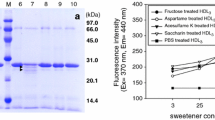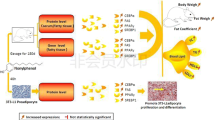Abstract
Acrylamide is a well-known potent carcinogen and neurotoxin that, until now, has not been sufficiently investigated with regard to its effects on lipid metabolism. We investigated physiological effects of acrylamide (AA) on lipoprotein metabolism using human macrophages, dermal cells, and zebrafish models. Functional and structural properties of lipoproteins were modified by AA (final concentration of 5–100 mM) with loss of antioxidant ability and multimerization of apoA-I in vitro. AA exacerbated LDL oxidation, degradation, and LDL uptake into macrophages with increased ROS production. In human cells, treatment of AA (1–100 μM) caused cellular senescence of dermal cells with severe cytotoxicity. Waterborne exposure of zebrafish in cage water containing AA (300 ppm) resulted in acute death within 26 h along with elevation of body weight, blood glucose, triglyceride, and hepatic inflammation. AA exposure caused fat accumulation in liver in a dose-dependent manner. In conclusion, AA affected lipoprotein metabolism to result exacerbation of atherosclerosis. Exposure of zebrafish to AA resulted in acute inflammatory death with hyperlipidemia.




Similar content being viewed by others
Abbreviations
- AA:
-
Acrylamide
- GOT:
-
Glutamic oxaloacetic transaminase
- GPT:
-
Glutamic pyruvic transaminase
- HCD:
-
High-cholesterol diet
- HDL:
-
High-density lipoproteins
- LDL:
-
Low-density lipoproteins
- ND:
-
Normal diet
- TC:
-
Total cholesterol
- TG:
-
Triglycerides
References
Bergmark, E. (1997). Hemoglobin adducts of acrylamide and acrylonitrile in laboratory workers, smokers and nonsmokers. Chemical Research in Toxicology, 10, 78–84.
Friedman, M. (2003). Chemistry, biochemistry, and safety of acrylamide. A review. Journal of Agricultural and Food Chemistry, 51, 4504–4526.
Shipp, A., Lawrence, G., Gentry, R., McDonald, T., Bartow, H., Bounds, J., et al. (2006). Acrylamide: Review of toxicity data and dose-response analyses for cancer and noncancer effects. Critical Reviews in Toxicology, 36, 481–608.
LoPachin, R. M., & Gavin, T. (2012). Molecular mechanism of acrylamide neurotoxicity: Lessons learned from organic chemistry. Environmental Health Perspectives, 120, 1650–1657.
Mottram, D. S., Wedzicha, B. L., & Dodson, A. T. (2002). Acrylamide is formed in the Maillard reaction. Nature, 419, 448–449.
Svensson, K., Abramsson, L., Becker, W., Glynn, A., Hellenäs, K. E., Lind, Y., et al. (2003). Dietary intake of acrylamide in Sweden. Food and Chemical Toxicology, 41, 581–1586.
Brantsaeter, A. L., Haugen, M., Mul, A. D., Bjellaas, T., Becher, G., Klaveren, J. V., et al. (2008). Exploration of different methods to assess dietary acrylamide exposure in pregnant women participating in the Norwegian Mother and Child Cohort Study (MoBa). Food and Chemical Toxicology, 46, 2808–2814.
Cho, K. H. (2009). Biomedicinal implications of high-density lipoprotein: Its composition, structure, functions, and clinical applications. BMB Reports, 42, 393–400.
Feng, H., & Li, X. A. (2009). Dysfunctional high-density lipoprotein. Current Opinion in Endocrinology, Diabetes and Obesity, 16, 156–162.
Park, K. H., Jang, W., Kim, K. Y., Kim, J. R., & Cho, K. H. (2010). Fructated apolipoprotein A-I showed severe structural modification and loss of beneficial functions in lipid-free and lipid-bound state with acceleration of atherosclerosis and senescence. Biochemical and Biophysical Research Communication, 392, 295–300.
Park, K. H., & Cho, K. H. (2011). High-density lipoprotein (HDL) from elderly and reconstituted HDL containing glycated apolipoproteins A-I share proatherosclerotic and prosenescent properties with increased cholesterol influx. The Journal of Gerontology Series A: Biological Sciences and Medical Sciences, 66, 511–520.
Jang, W., Jeoung, N. H., & Cho, K. H. (2011). Modified apolipoprotein (apo) A-I by artificial sweetener causes severe premature cellular senescence and atherosclerosis with impairment of functional and structural properties of apoA-I in lipid-free and lipid-bound state. Molecules and Cells, 31, 461–470.
Kim, J. Y., Seo, J., & Cho, K. H. (2011). Aspartame-fed zebrafish exhibit acute deaths with swimming defects and saccharin-fed zebrafish have elevation of cholesteryl ester transfer protein activity in hypercholesterolemia. Food and Chemical Toxicology, 49, 2899–2905.
Stoletov, K., Fang, L., Choi, S. H., Hartvigsen, K., Hansen, L. F., Hall, C., et al. (2009). Vascular lipid accumulation, lipoprotein oxidation, and macrophage lipid uptake in hypercholesterolemic zebrafish. Circulation Research, 104, 952–960.
Havel, R. J., Eder, H. A., & Bragdon, J. H. (1955). The distribution and chemical composition of ultracentrifugally separated lipoproteins in human serum. Journal of Clinical Investigation, 34, 1345–1353.
Park, K. H., Shin, D. G., Kim, J. R., & Cho, K. H. (2010). Senescence-related truncation and multimerization of apolipoprotein A-I in high-density lipoprotein with an elevated level of advanced glycated end products and cholesteryl ester transfer activity. The Journal of Gerontology Series A: Biological Sciences and Medical Sciences, 65, 600–610.
Blois, M. S. (1958). Antioxidant determinations by the use of a stable free radical. Nature, 181, 1199–2000.
Noble, R. P. (1968). Electrophoretic separation of plasma lipoproteins in agarose gel. The Journal of Lipid Research, 9, 693–700.
Nusslein-Volhard, C., & Dahm, R. (2002). Zebrafish: A Practical Approach. Oxford: Oxford University Press.
Park, K. H., & Cho, K. H. (2011). A zebrafish model for the rapid evaluation of pro-oxidative and inflammatory death by lipopolysaccharide, oxidized low-density lipoproteins, and glycated high-density lipoproteins. Fish & Shellfish Immunology, 31, 904–910.
Yoon, J. H., & Cho, K. H. (2012). Point mutant of apolipoprotein A-I (V156K) showed enhancement of cellular insulin secretion and potent activity of facultative regeneration in zebrafish. Rejuvenation Research, 15, 313–321.
Jin, S., & Cho, K. H. (2011). Water extracts of cinnamon and clove exhibits potent inhibition of protein glycation and anti-atherosclerotic activity in vitro and in vivo hypolipidemic activity in zebrafish. Food and Chemical Toxicology, 49, 1521–1529.
Owusu-Ansah, E., Yavari, A., Mandal, S., & Banerjee, U. (2008). Distinct mitochondrial retrograde signals control the G1-S cell cycle checkpoint. Nature Genetics, 40, 356–361.
Hogervorst, J. G., Baars, B. J., Schouten, L. J., Konings, E. J., Goldbohm, R. A., & van den Brandt, P. A. (2010). The carcinogenicity of dietary acrylamide intake: A comparative discussion of epidemiological and experimental animal research. Critical Reviews in Toxicology, 40, 485–512.
Toker, A., Yerlikaya, F., Yener, Y., & Toy, H. (2013). Serum homocysteine, arginine, citrulline and asymmetric dimethyl arginine levels, and histopathologic examination of the abdominal aorta in rats exposed to acrylamide. Biotechnic and Histochemistry, 88, 103–108.
LoPachin, R. M., Gavin, T., & Barber, D. S. (2008). Type-2 alkenes mediate synaptotoxicity in neurodegenerative diseases. Neurotoxicology, 29, 871–882.
Catalgol, B., Ozhan, G., & Alpertunga, B. (2009). Acrylamide-induced oxidative stress in human erythrocytes. Human and Experimental Toxicology, 28, 611–617.
Bjellaas, T., Olesen, P. T., Frandsen, H., Haugen, M., Stølen, L. H., Paulsen, J. E., et al. (2007). Comparison of estimated dietary intake of acrylamide with hemoglobin adducts of acrylamide and glycidamide. Toxicological Sciences, 98, 110–117.
Acknowledgments
This work was supported by the Mid-carrier Researcher Program (2014-11049455) and Basic Science Research (2010-020910) program through the National Research Foundation of Korea (NRF). The authors are grateful for the BK21 plus program of the National Research Foundation for the support of graduate students.
Conflict of interest
No competing financial interests exist.
Author information
Authors and Affiliations
Corresponding author
Additional information
Seong-Min Kim, Ji-Mi Baek and So-Mang Lim are co-first authors.
Electronic supplementary material
Below is the link to the electronic supplementary material.
Rights and permissions
About this article
Cite this article
Kim, SM., Baek, JM., Lim, SM. et al. Modified Lipoproteins by Acrylamide Showed More Atherogenic Properties and Exposure of Acrylamide Induces Acute Hyperlipidemia and Fatty Liver Changes in Zebrafish. Cardiovasc Toxicol 15, 300–308 (2015). https://doi.org/10.1007/s12012-014-9294-7
Published:
Issue Date:
DOI: https://doi.org/10.1007/s12012-014-9294-7




